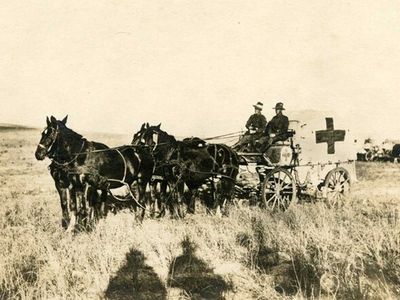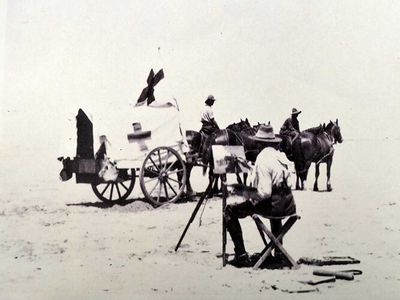“Major Avery, among many other Old Boys, holds a special place on the TGS Old Boys’ Wall of Achievement for his role in inventing the “Rapid Transit Ambulance” that was a key part of the Australian Light Horse Brigade.”

On ANZAC Day, we come together to reflect on the importance of service and sacrifice.
Toowoomba Grammar School would like to acknowledge our admiration for the loyalty, service and bravery exhibited by TGS Old Boys who so valiantly served. We are all the beneficiaries of their sacrifice, and their selfless actions continue to inspire a spirit of service amongst our current students.
Today we focus on the contribution of one TGS Old Boy who made a significant contribution to World War I. Here is some of the incredible story of Major Avery, DSO and if you visit the School Museum and Archives you can see a display in his honour.
Much of this history has been captured through countless hours of dedication and devotion by current TGS museum volunteer and former TGS staff member, Mrs Ann Hallam who managed the School’s Cadet Unit from 2006-2019.
Major Avery DSO, inventor of the WWI “Rapid Transit Galloping Ambulance”
Distinguished TGS Old Boy, Leonard Grimes (1880-1885) was born in Queensland in 1869 and died in 1953. Grimes attended the School in the days of Sir Harry Chauvel and Sir Littleton Groom and while at TGS was known as Leonard Avery Grimes.
After his School days he went on to Wadham College, Oxford, where he graduated with a medicine degree. He later changed his name to Conrad Avery and after some years as a hospital physician and surgeon, Avery enlisted with the British Army and joined the Suffolk Imperial Yeomanry. He was later promoted to Major and joined the Royal Army Medical Corps. During World War I he was enlisted with the Royal Westminster Dragoons and served in Palestine, Egypt and Syria.
Major Avery, among many other Old Boys, holds a special place on the TGS Old Boys’ Wall of Achievement for his role in inventing the “Rapid Transit Ambulance” that was a key part of the Australian Light Horse Brigade.
Light Horse Field Ambulance
The Light Horse units were mounted infantry with efficient mobile medical support to the wounded and sick soldiers of an Australian Light Horse Brigade. The Field Ambulance ensured the removal of the wounded from the front line to the advanced dressing station where there were surgical and resting tents.
These sand carts had two wheels with tyres that were wide enough to stop the cart digging into soft sand and could carry two or three stretchers. In heavy sand four horses were necessary to pull the cart, and the cart had to be steered by a rider on one of the lead horses.

Australian Light Horseman
The 2nd Light Horse Field Ambulance was formed in Brisbane with much of the unit coming from Queensland.
More than 15 TGS Old Boys enlisted with the Second Light Horse Brigade, two of whom died at Gallipoli: Major Dugald Maxwell Lockwood Graham and Trooper Gordon Holmes Robertson.
During the World War I, George W. Lambert (1873-1930) served Australia as an Official War Artist attached to the ANZAC Mounted Division. He spent two terms in service, the first with the Light Horse in Palestine, and the second in Gallipoli and Egypt before his military contract discharge.
As a result of Lambert’s service during World War I, he was offered a variety of commissions to paint scenes from significant war time events, including an activity of the 2nd Australian Light Horse Field Ambulance, Walk (An Incident at Romani).
The Battle of Romani was the last ground attack on the Suez Canal at the beginning of the Sinai and Palestine Campaign. The battle was fought from 3 to 5 August 1916 near the Egyptian town of Romani.
The completed painting was to be given to the Queensland (National) Art Gallery by the Light Horse in memory of their fallen comrades.
The Rapid Transit Ambulance
Major Avery describes his vision for a new galloping ambulance, known as “The Rapid Transit Ambulance”.
This ambulance was designed with a view to filling the want of stretcher bearers with mounted troops. The endeavor has been to construct a light strong carriage easily adjustable to any mounted horse and capable of keeping up with cavalry through any sort of country. As will be seen from the accompanying illustration, the ambulance is a two-wheeled contrivance.
The body consists of a platform fixed to a crank axle by long springs between 46-in. wheels. This platform is 2 ft. 3 in. from the ground and is arranged to carry an ordinary service stretcher. The forepart consists of a pair of short shafts which are attached to the body by an arrangement of springs adapted to prevent the side-to-side motion caused by the action of the horse. The shafts reach as far forward as the saddle flaps, where they are held in position by a girth strap, breastplate, and belly-band.
The body is covered by a canvas hood. The weight is about 3 cwt. Length overall, 12 ft. Track, 4ft. 1 in. Surgical dressings, splints, water-bottle, &c., are carried. It is quite easy for the driver, having placed a wounded or helpless man in a stretcher, to transfer him from the ground to the platform of the carriage single-handed.
This ambulance has been on duty with the Suffolk, Sussex, Surrey and Middlesex Imperial Yeomanry during their respective training, and with the Wiltshire Yeomanry through the recent maneuvers. It is a very comfortable conveyance and has proved capable of negotiating with almost any country.
Walk (An Incident at Romani)
The incident to which Lambert’s painting refers occurred during the Battle of Romani on 4 August 1916. The 2nd Light Horse Field Ambulance had deployed two sand-carts to an exposed part of the line to retrieve some seriously wounded men. Upon its return journey the Field Ambulance envoy came under Turkish fire and its panicked horses started to bolt.
Tragedy was averted when the corporal signaled ‘Walk’ and galloped to the front of the party to steady the teams. After the horses had been calmed and resumed their pace, the enemy apparently recognised the Ambulance’s mission and averted their fire. As a result of their bravery and composure during the incident the corporal and drivers were awarded Military Medals.

To enable Lambert to make sketches of the event that was already three years in the past, it was re-enacted at Kantara, Egypt in 1919. Photographs were taken of Lambert at work sketching this re-enactment. The completed painting portrays the moment when the corporal signals ‘Walk’ whilst rushing to the front of the group to steady the bolting teams.
Remembrance Day
Remembrance Day marks the anniversary of the Armistice which ended the First World War, signed at 11:00am on 11 November 1918. We still remember those who have given their lives in conflict before and since, by taking a minute to stop, be silent and remember the war that was to end all wars.
Latest Blog
Tik Tok - From Fun to Fear
Social media platforms have ingrained themselves into our daily lives in a time when technology is constantly evolving and drawing millions of users with seductive features and never-ending streams of captivating content. Among these, TikTok has become a worldwide phenomenon, captivating users with its viral challenges and short-form films. Underneath the fun and inventiveness however, there is growing concern about the risks connected to TikTok and other social media platforms. TikTok's…
Active Procrastination – Unlocking the Gates of Time
“Procrastination is like a credit card: it’s a lot of fun until you get the bill.” - Christopher Parker – professional actor. Unfortunately, procrastination is a term that we are all familiar with as students; the vast majority of us have experienced it firsthand. It saps our time and results like a parasite, a burden on its host. However, despite it’s reputation, recent studies have shown that when harnessed correctly, procrastination can be a powerful tool to improve both academic efficiency…
It Takes a Village...
The Toowoomba Grammar School Boarding community plays a pivotal role in shaping the young minds of our boarders and instilling values whilst creating a sense of mateship that can last a lifetime. The nurturing and supportive network of staff not only ensure a safe and structured environment but also cultivates a sense of belonging and camaraderie among the boys. ‘The staff supply the fuel to the ship but ultimately it is the boys who steer it and decide upon its final destination’. Our TGS…
Unlocking Literacy - The Big Six Elements for Your Child’s Reading Success
Literacy skills are a core component of each day for our students, and parents often ask how they can support this from home. I am delighted to share with our parent community the essential components that underpin successful reading development. These elements, known as the Big Six, provide a solid foundation for your son’s literacy journey. These critical building blocks include: Oral Language: Communication skills are the bedrock of reading. Encourage rich conversations with your child.…
The Journey of a Boarding Mother
When you look up mother in the dictionary it reads: female parent of a child. When you look up boarder, it simply reads: a child who lives away from home. So, put “boarder mother” together and we have: the female parent of a child who lives away from home – if only it were that simple. My definition of boarding mother is: a strong, dedicated unbelievably great female parent of a child who has the wisdom to put her son’s educational needs, wellbeing and lifelong endeavours before her own. A…
The Importance of Differentiation
As parents, we all want our children to have the best possible education, and one of the most effective ways for teachers to provide this is through differentiation. Differentiation means tailoring instruction to meet the unique needs and interests of each student, and it can take many forms. First, let's define differentiation. Differentiation is a teaching approach that recognises that students have different strengths, interests, and learning styles. By adjusting instruction to meet these…
Addressing Anger in Teenage Boys
As a community dedicated to the growth and well-being of our teenage boys, it is essential to address the complexities of emotions we experience during adolescence. Among these emotions, anger stands out as a powerful and intense feeling that can influence their behaviour, relationships and overall wellbeing. Untreated anger can lead to a myriad of problems and challenges for our young boys. In this comprehensive guide, we will explore the dangers of untreated anger, ways to support healthy…
Study Skills Program
Just as teachers benefit from an understanding of the Learning Sciences in their lesson planning and preparation, so to do students when they are studying for major summative assessments. A survey of TGS students in Years 9 to 12 found that 70% of our boys felt that they knew how to study, with the biggest impediments to study being lack of motivation and too many distractions. The most highly preferred study technique was found to be rewriting notes. Cramming, rereading the text and rewriting…
Developing Teachers Worldwide
I recently had the pleasure of attending the 2023 International Boys’ Schools Coalition (IBSC) Annual Conference at Westlake Boys High School in Auckland, New Zealand, in my capacity as a Team Leader in the IBSC Action Research Program. Action research is a systematic inquiry conducted by teachers in their own classroom to better understand the impact that an aspect of their practice is having on their students. Each year, 40 teachers from IBSC member schools from around the world are accepted…